Jul-10-20
 | | KEG: A long game that was effectively over by move 11. After a sloppy opening, Winawer unaccountably sacrificed two pieces for an attack that wasn't truly there. Alapin returned one of the piece, and the balance of the game did little other than confirm that Winawer could not afford to spot Alapin a piece. The only interest of the game is to watch what we rarely see today, a game in classical chess times in which one player spots the other a piece, Alapin could have closed out the game faster, but he never gave Winawer a chance to recover after move 11. At the end, Alapin returned his extra piece to force a winning minor piece ending. Perhaps not the most satisfying or quick conclusion, but it did the job. 1. e4 e6
2. d4 d5
3. Nc3 Nf6
4. Bg5 Be7
5. BxN
An old line that goes back to Adolf Andersen. It is pretty clearly inferior to the normal 5. e5, but was nonetheless a favorit of Andersen, Bird, Steinitz, Blackburne, Gunsberg, Showalter, Charousek, and Winawer. Given Winawer's familiarity with this line, it is remarkable that his opening play from this point was so feeble. 5... BxB
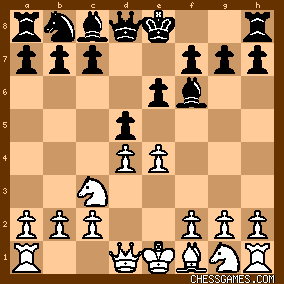
click for larger view6. Bd3?
A novelty never played before or since so far as I can determine. And for good reason. It should simply lose a pawn. Best for White is 6. Nf3.
After 6. Bd3?, the position was:
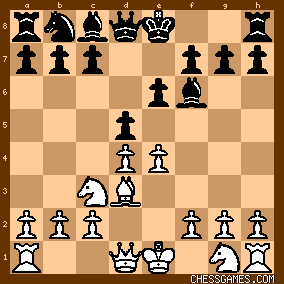
click for larger view6... c5?
Why not simply 6...dxe4 7. Nxd4 Bxd4. True, White is then better developed. But a pawn is a pawn. 7. Nf3?
Another lemon. White has a plethora of better options: 7. dxc5; 7. e5; 7. exd5. But after 7. Nf3?, White was again in trouble:
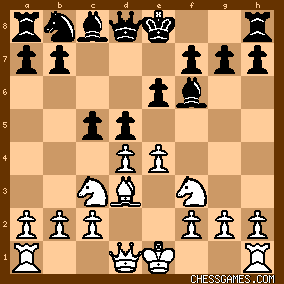
click for larger view7... 0-0?
Safe and solid. But why not go for the gold with 7...cxd4 after which Black has close to a won game. 8. e5 Be7
9. dxc5
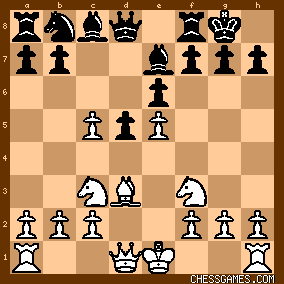
click for larger view9... f6?
"!"--(Tournament Book)
The Tournament Book is out to lunch here. Black would have the better game with 9...Nd7 or 9...Nc6 or 9...Bxc5 Now, White could have a decent game with 10. 0-0 or 10. exf6. But Winawer had delusions of a King-side attack, and played: 10. h4?!
Winawer should have been punished for this, but Alapin responded: 10... Nc6
10...Bxc5 was better. After the text, the position was: 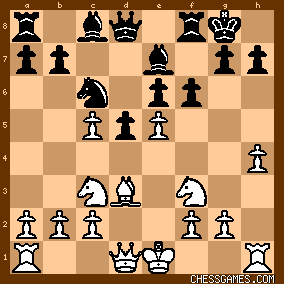
click for larger viewThis is where matters stood (with Black perhaps slightly better) when Winawer decided on a wild (and losing) sacrificial line. |
|
Jul-11-20
 | | KEG: Post II
11. Bxh7+?!
A wild and unjustified combination. The best explanation I can give is that Winawer was playing the final tournament of his life and was in 13th place with no chance of significantly improving his situation and no chance of being overtaken by last-place Didier (who was in the midst of forfeiting his final two games for "indisposition"). Winawer perhaps decided to avoid a long game and thus went for broke. As it turned out, he got the worst of both worlds: he wound up losing a long game. Winawer would have had a playable game with 11. exf6. The Tournament Book said that this would be terrible for White after 11...Rxf6 12. Ng5 Rh6 ("!"). But White could simply play 12. Qd2 or 12. Qe2. Moreover, White would be OK with 12. Ng5? Rh6? 13. f4. But in this variation, Black would be better with 12...h6 instead of 12...Rh6. Winawer would also have had a playable though inferior position with 11. Ng5 h6 12. exf6 Rxf6 13. Nf3. If in this variation Black plays 11...fxN? White draws brilliantly with 12. Bxh7+ KxB (not 12...Kh8?? 13. Qh5 with mate to follow) 13. hxg5+ Kg8 14. Rh8+! Kf7 (not 14...KxR?? 15. Qh5+ Kg8 16. g6 and mate in two) 15. Qh5+ g6 16. Rh7+ Ke8 17. Qxg6+ Kd7 18. Nxd5!! exN 19. Qd6+! Ke8 20. Qg6+ and draws via perpetual check. Perhaps the above variations after 11. Ng5 would have provided the quick brilliant finish Winawer wanted as this (for him unfortunate) final tournament of his career wound down. Anyway, back to the actual game after 11. Bxh7+?! 11... KxB
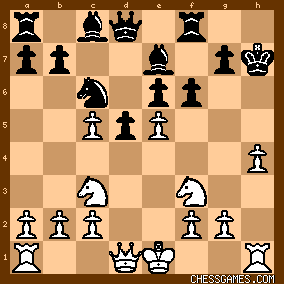
click for larger view12. Ng5+
Like it or not, having said "A" (the Bishop sacrifice), Winawer might as well go on to "B" (a Knight sacrifice). 12. exf6 was no real improvement: 12. exf6 Rxf6 13. Ng5+ Kg8 14. Qh5 Rh6! 15. Qf7+ Kh8 16. 0-0-0 Bd7 after which White's attack, though scary looking, has pretty much wound down. 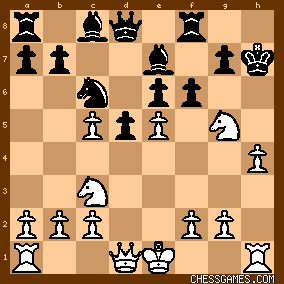
click for larger view12... Kg8!
12...fxN? would allow White to draw by perpetual check via the route discussed above after 11. Ng5 fxN. The text looks ugly, but it wins! 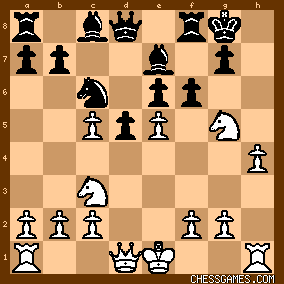
click for larger view13. Qh5?!
White had nothing better than 13. exf6 Rxf6 14. Qh5 Rh6 15. Qf7+ Kh8 16. 0-0-0 Bd7 with a won game for Black. So Winawer decided to double-down on his Knight sacrifice and go down with all guns blazing. 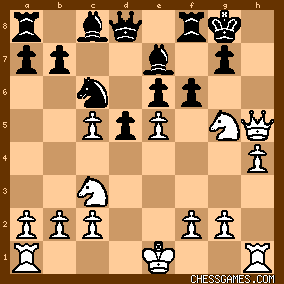
click for larger view13... fxN
This time Alapin had to take the Knight, since anything else leads to mate. 14. hxg5
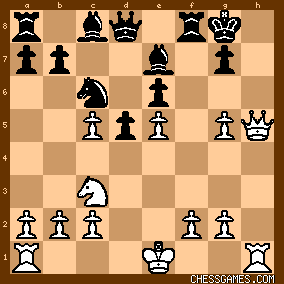
click for larger viewWinawer now had an open h-file on which to operate, but he was down two pieces. Alapin now had a number of roads to victory. All he had to do was be careful. |
|
Jul-11-20
 | | KEG: Post III
14... Nxe5
One of many ways to win. Also decisive were:
A) 14...Rf5 15. f4 (if 15. Qh7+ Kf7 16. g6+ Ke8 17. Qxg7 Kd7 leaving Black two pieces ahead with his King safe) Nxe5 16. 0-0-0 (if 16. fxe5 Bxg5 17. Qh8+ Kf7 18. QxQ Rxe5+ 19. Kf2 Rf5+ 20. Ke2 BxQ) Bxg5! 17. Qh8+ Kf7 18. fxB QxQ 19. RxQ Ke7 20. Nb5 Nf7 21. Rg8 Rxg5 22. Nc7 Rb8 23. Re1 Ne5 24. Re8+ Kd7 25. Nxe6 Rxg2 26. Nf4 Rg4 27. R1xe5 RxN and Black with his extra piece must eventually win. Needless to say, the above variation would be nearly impossible to compute over the board. B) 14...Qc7 15. f4 Nxe5! 16. 0-0-0 Ng6! 17. QxN Qxf4+ 18. Kb1 Qxg5 19. Qh7+ Kf7 leaving Black a piece ahead. This variation, in contrast to "A," might actually be found over the board. In any case, Alapin's actual 14...Nxe5 was a winner, and the sort of move a strong player would more easily be able to assess with the clock ticking, the position now being: 
click for larger view15. g6
The only possible way of continuing the attack. If 15. Qh7+ Kf7 16. Qh5+ Ng6 17. Qf3+ Kg8 (clearer than 17...Ke8 18. Qh5, which would likely also win). After 15. g6, the position was:
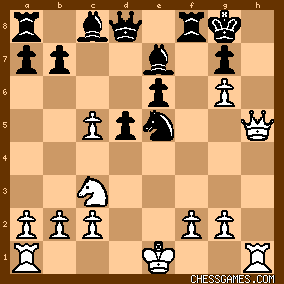
click for larger view15... Nxg6!
Obviously, anything else gets Black mated.
16. QxN
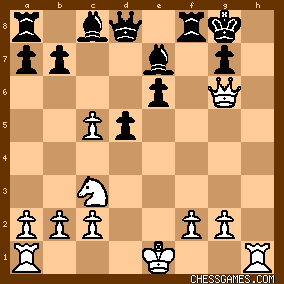
click for larger view16... Bf6!
16...Bxc5 is theoretically best, but over the board, the text is a simple way to ensure victory. 17. Qh7+
17. 0-0-0 is perhaps a better try, as is 17. Rh3. In either case, however, Black should still come out on top. If 17. 0-0-0 BxN! 18. Qh7+ Kf7 19. bxB Qg5+ 20. Kb2 Bd7 and White, down a piece and with a tripled isolated pawn, is pretty much sunk. If 17. Rh3 e5 (allowing the Black Bishop on c8 to attack the h3 Rook) 18. g4 e4 (18...Bh4 also wins) 19. 0-0-0 Bg5+ 20. Kb1 Bxg4 21. Qh7+ (21. Rxd5 BxR 22. RxQ BxR and Black with two Rooks plus Bishop for Queen must win) Kf7 22. Nxe4 Bf4 23. Nd6+ BxN 24. Rg1 Rh8 25. Rf3+! (the only chance) BxR 26. Qg6+ Ke7 27. cxd6+ Qxd6 28. Qxg7+ Ke6 29. Rg6+ Kf5 30. Qf7+ (not 30. RxQ Rh1) and mate next move) Ke5 31. Rg5+ (the nasty back-rank mate still precludes White from snatching the Queen) Kd4 32. QxB Kc5 and Black--with his extra Rook--must eventually win. 17... Kf7
18. Qh5+
18. 0-0-0 might have yielded slightly better chances,but after 18...Qc7 or 18...Qe7, Black must ultimately win. After 18. Qh5+, the position was:
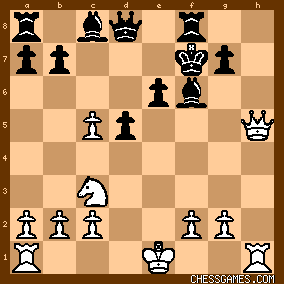
click for larger view18... g6
"!"--(Tournament Book)
18...Ke7 would almost certainly also have been sufficient to win, but the text was best, and left the position as: 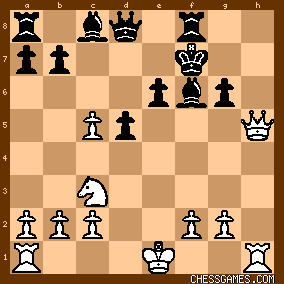
click for larger viewAs I will discuss in my next post on this game, in this position Winawer by-passed his last practical chance to save the game (as a theoretical matter, of course, he was lost in any case). |
|
Jul-11-20
 | | KEG: Post IV
19. Qe2?
Effectively conceding the game.
"If now 19. Qh7+ Bg7 20. Rh3 [20. Qh3 is probably slightly better, but ultimately unavailing--KEG] Rh8 [this wins, but faster and stronger is the immediate (temporary) Queen sacrifice 20...Qf6! 21. Rf3 QxR 22. gxQ Rh8 regaining the Queen and winning--KEG] 21. Rf3+ Qf6 22. RxQ+ KxR 23. QxR RxQ (Alapin)." The only real chance for White here was 19. Qg4 followed by 20. 0-0-0. This would at least have permitted White to keep up his attack for a while. After the text, Alapin was able to regroup and White's practical chances were gone. 19... Rh8
19...Bd7 would also have been winner.
20. 0-0-0
Bringing the other Rook to the show, but by now it was too late to change the outcome. 20... Bd7
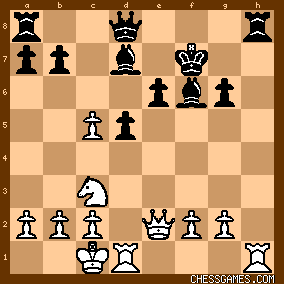
click for larger view21. Qf3
Winawer (understandably) seems to have lost heart by this point. If he seriously wanted to try to battle on, he probably should have tried 21. Rhe1. 21... RxR
By this stage, Alapin no longer seems to have been looking for the strongest or fastest way to win, he just wanted to get the job done. 21...Qc7 or 21...Rc8 or 21...Bc6 were all more forceful. But trading off a pair of Rooks was a simple winning strategy, and probably the most sensible over the board. 22. RxR
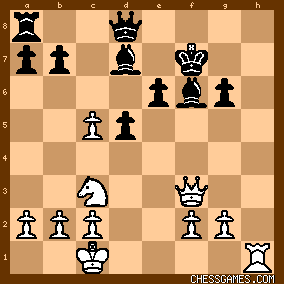
click for larger viewWinawer could soldier on for a while here and create threats (and perhaps the move 30 time control in such a complex tactical struggle was becoming a factor), but he was running out of pieces. 22... Kg7
Adopting the simple course of denying White a chance to play Rh7+. Theoretically, faster were 22...Qc7 or 22...Rc8 or even 22...Kg8. 23. Qe3
The "threats" created by this move were childishly easy to parry. 23. Ne2 might at least have brought another piece to whatever remained of White's attack. 23... Bg5
Again taking the simple approach rather than taking the express lane with 23...Rc8 or 23...Qe7. 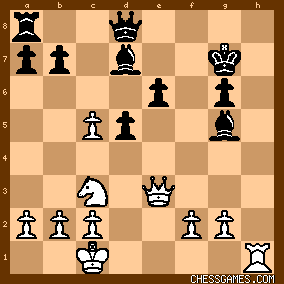
click for larger view24. f4 Bf6
25. Ne2 Qe7
25...Qa5 was fastest. The text allowed Winawer time to try one final tactical trick. 26. g4!
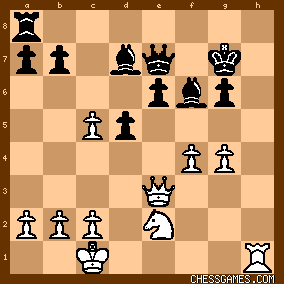
click for larger view26... Rh8
Alapin's threat of trading pieces stymied Winawer's schemes. 27. Re1
27. RxR was perhaps theoretically better, but trading pieces was hardly a winning tactic for Winawer at this point. 27... Kf7
27...g5 would have put an end to Winawer's dreams. But with the clock ticking the text was entirely logical. 28. c3
Unduly worried about the Bishop on the a1..h8 diagonal, Winawer ignored his only real way to ratchet up any sort of attack (28. g5). 28... Rc8
28...e5 was probably even stronger, but the text was plenty effective: 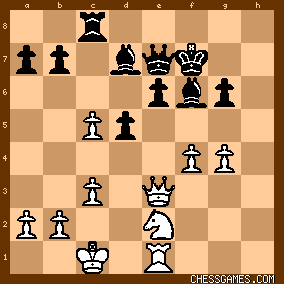
click for larger viewIncredible as it may appear, the game was not yet quite half-way over. If Winawer wanted a quick game, he might have thrown in the towel here. Instead, he struggled on for another 29 moves, searching in vain for some sort of attacking chances. |
|
Jul-11-20
 | | KEG: Post V
29. c6
Another desperate shot. Winawer had nothing better. 29... bxc6
29...Rxc6 also wins.
30. g5
The best chance to complicate. But it made Alapin's remaining move before the time control easy. 30... Bg7
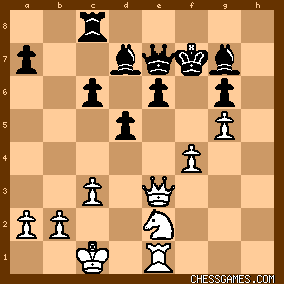
click for larger view31. Ng3?!
He had nothing better than 31. Qxa7 or 31. Nd4.
31... Qd6
The real crusher was 31...d4! 32. cxd4 Qb4 33. Re2 (33. Rd1 c5!) Qxd4. But the text required little calculation and also wins handily. 32. Qxa7
Having foregone his opportunity a move later, Winawer now had to settle for 32. Rd1. After the text, Winawer had no further chance even to complicate: 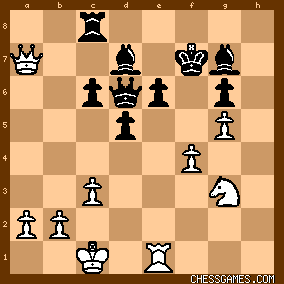
click for larger view32... Qxf4+
32...c5! was even more lethal.
33. Kb1 Ke8
The simplest. It put an end to Winawer's "attack." 34. Ne2
Winawer wanted to avoid exchanges, but this move should have allowed Alapin to win immediately. Like it or not, Winawer--if he didn't want to resign--had to play 34. Qe3. After 34. Ne2, the position was: 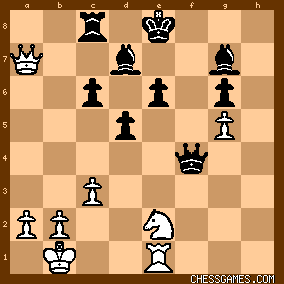
click for larger view34... Qh4
Prolonging the struggle. 34...Qd2! would undoubtedly have elicited Winawer's resignation. 35. Qg1
Taking advantage of the opportunity to play on for at least a bit. 35... c5
35...e5 was also a killer.
36. Nc1
Hopeless. 36. Qg3 or 36. Qh1 would have allowed Winawer to trade Queens, but might have avoided immediate catastrophe. 36... Rb8
36...d4 and 36...e5 would likewise have spelled fini for Winawer. 37. Re2
I'm out of ideas for White here.

click for larger view37... Bxc3
38. Qxc5
Again giving Alapin a chance to end the game.
38... Qb4
Knowing that Winawer was not going to trade Queens, Alapin could indulge himself with this move rather than calculating the effect of the crushing 38...Bd4! 39. Qf2
Utterly hopeless, but so was trading Queens.
39... Bd4
39...e5! would have overwhelmed White. But Alapin was playing simply, having the win in hand. 40. Qh2
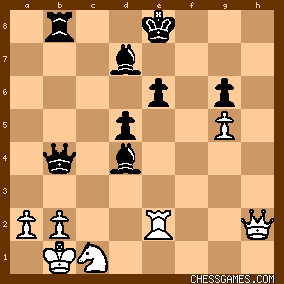
click for larger viewIn this position, as I will discuss in my next post on this game, Alapin decided to return the extra piece and force an easily won minor piece endgame. Alapin could of course have played 40...Rc8! and destroyed the White position. But (Alapin apparently thought) why calculate lengthy variations when a simple means of ending the game is at hand? |
|
Jul-12-20
 | | KEG: Post VI
40... Qxb2+
Now Alapin gets an easily won minor piece ending. His bounty for the pieces Winawer had sacrificed nearly 30 moves earlier: 41. RxQ RxR+
42. QxR BxQ
43. KxB
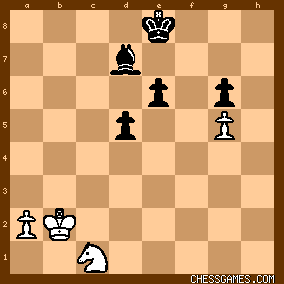
click for larger view43... Ke7
Black's winning procedure is childishly simple. Bring the King into action, advance his two connected center passed pawns, and keep an eye on White's a-pawn with his Bishop and/or his King. 43...Bb5 would also have won easily.
44. Nd3
White has no defense.
44... Kd6!
Some care was necessary. If now 44...Bb5? White wins the Black g-pawn with 45. Ne5 and draws the game. Even very easy endgames can be botched! The text prevents Ne5 and basically cinches the game for Black. 45. Kc3
This gives Black an extra tempo (not that he really needed it) since the coming d4 will now be with check. This could be avoided with 45. Kb3, not that this had any likelihood at changing the ultimate outcome. 45... e5
The pawn march begins. White is helpless:
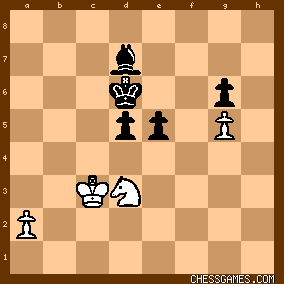
click for larger view46. Ne1
Winawer decided to keep the Knight at home to do battle against Black's advancing pawns while sending the King off to support his a-pawn. A valiant but hopeless effort to avoid the inevitable. 46... d4+
47. Kb4
The King march (and a-Pawn march) begins. All a waste of effort by now. 47... Bf5
Alapin was in no rush. 47...e4 would have shortened proceedings. 48. a4 Be4
Perhaps enjoying the show too much to pull the trigger with 48...e4. 49. a5 Kc6
Still taking the slow boat. Black could have crushed Winawer's plans with 49...Bb7, or just gotten on with his own pawn advance with 49...Kd5 (after which he had no reason to fear 50. a6 because of 50...Kc6). 50. Kc4 Kb7
Alapin's win was so clear he could afford to proceed in this plodding fashion without taking the slightest risk of blowing his win. 51. Kb3 Bd5+
52. Kb4
This hastens the end, but this ending could not have been much fun for Winawer. 52... Be4
53. Kc4 Kc6
Alapin, in repeating the position, was probably just saving time. 54. Kb4 Kd5
Time to get serious:
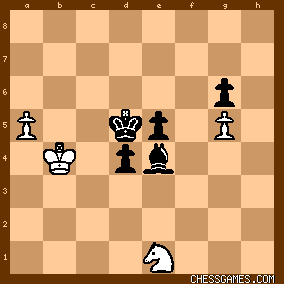
click for larger view55. Kb5
Going for broke.
55... d3
56. a6 Kd4
Unleashing the Bishop to cover a8. The game was now over: 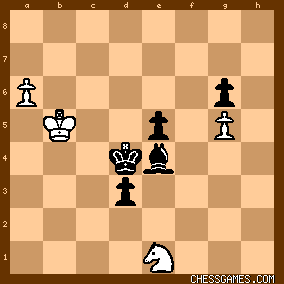
click for larger view57. a7 Kc3
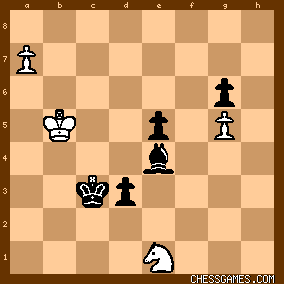
click for larger view0-1
Black can only stop the d-pawn by giving up his Knight. Even then, he could not hope to survive very long. Resignation was long past due. |
|
|
|
|





































